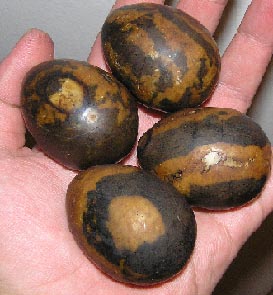Bezoar stones and Mustika pearls are unusual objects formed in
animals and plants. They are also known as enteroliths, stones that naturally occur
in the digestive tracts of animals - usually within hollow organs and ducts.
Typically, these stones are formed after an animal eats a substance that
their bodies are unable to digest, and then accumulates and hardens as deposits
along the abdominal tract. They assume many different shapes, from regular
oyster-pearls to tumbled looking stones in unusual shapes and sizes. In their
unpolished state, they have a rough texture. Unlike oysters that form pearls
out of irritation, Nature forms mustika pearls in the bodies of animals, plants
and fruits. Not all animals or plants of the same species form these
pearls, but it is possible they do occur in almost every living being. Some
mustikas are actually fossilized parts of an animal or plant, such as the eye.
The word "Mustika" comes from the Kawi language, of an old Javanese
origin and translates to, "magic jewel," or "precious
stone." Mustikas are widely known in South-East Asia, India, and
other countries of the East. Possessing a mustika means the owner will acquire great
fortune and blessings. These magical pearls are one-of-a-kind, unique, rare,
and powerful. It is said that only
fortunate people are able to acquire and keep them.

















No comments:
Post a Comment